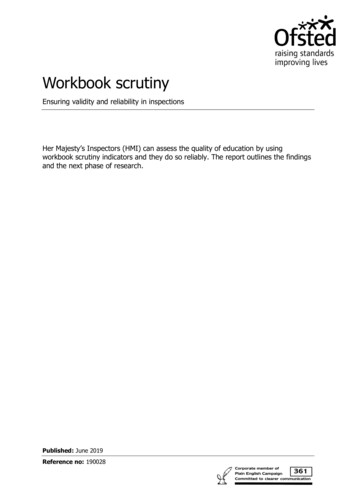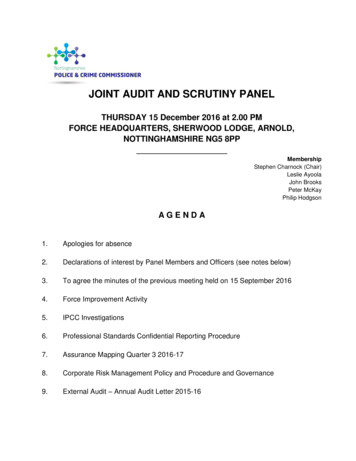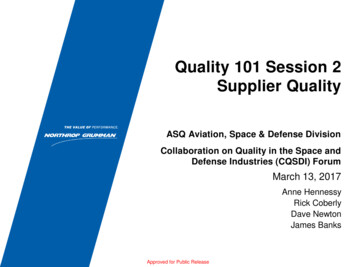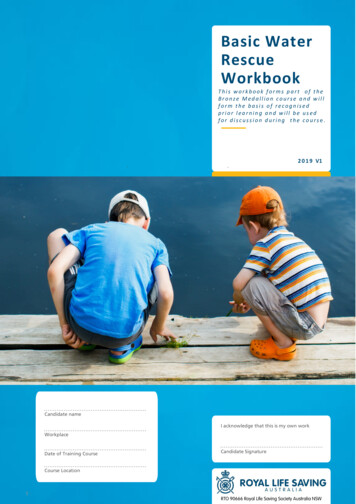
Transcription
Workbook scrutinyEnsuring validity and reliability in inspectionsHer Majesty’s Inspectors (HMI) can assess the quality of education by usingworkbook scrutiny indicators and they do so reliably. The report outlines the findingsand the next phase of research.Published: June 2019Reference no: 190028
alsIndicatorsData collection processData analysis334566Research findings6Research question 1: Does the piloted approach to book scrutiny allow meaningfulassessment of the quality of education?6Research question 2: Can inspectors rate reliably using the piloted book scrutinyindicators?9Conclusions and next stepsWorkbook scrutinyJune 2019, No. 190028112
IntroductionThe focus of inspection under the new framework has shifted to the quality ofeducation more broadly. Some of the evidence inspectors will gather during aninspection under the new education inspection framework (EIF) will feed in to theoverarching judgement on the quality of education. For example, conversations withleaders shed light on how curriculum is conceptualised, while lesson observationsand workbook scrutiny provide a window into the quality of curriculumimplementation.In order to ensure a standard and consistent approach to inspections, we developedand piloted a number of indicators (or assessment criteria). These indicators unpackessential aspects of education in relation to curriculums, teaching and learning. Weselected a few of those indicators and further tailored these to workbook scrutiny.This report sets out a recent pilot of indicators and rating scales for workbookscrutiny. We needed to investigate their validity and fitness for purpose, so our firstquestion was:1. Does the piloted approach to workbook scrutiny allow meaningfulassessment of the quality of education?The study design also included an initial and small-scale exploration of reliability, sowe also asked:2. Can inspectors rate reliably using the piloted workbook scrutiny indicators?The first research question was answered through the findings arising fromquestionnaire and focus group feedback of the participating HMI. The second onewas answered through a statistical analysis of the level of agreement between HMIjudgements.MethodologyThis was a mixed methods study, with the convergent parallel design.1 We collectedboth quantitative and qualitative data to allow a more rounded validation of thepiloted indicators and rating scales. This is the first phase of a multi-phase researchproject.ParticipantsNine HMI participated in the pilot study. Most of them (n 7) have substantialexperience of two to three years or more in the role. Two HMI have one to two yearsof experience or less. Their subject expertise were in English, mathematics, science,1JW Creswell and VL Plano Clark, ‘Designing and conducting mixed methods research’, SAGEPublications, 2011.Workbook scrutinyJune 2019, No. 1900283
history and geography. They scrutinised workbooks within and outside of their areasof expertise (see Table 1).Table 1: Areas of expertiseAreas of expertiseAreas outside of specialismHMI 1EnglishScienceHMI 2EnglishHistory/geographyHMI 3MathematicsEnglishHMI 4MathematicsEnglishHMI 5ScienceEnglishHMI 6ScienceMathematicsHMI 7HistoryFrench, scienceHMI 8FrenchHistory/geographyHMI 9FrenchMathematicsMaterialsWe obtained workbooks from primary and secondary schools to ensure that keystages 2 and 3 were represented (see Table 2). The subjects matched theparticipating HMIs’ areas of expertise.Table 2: The range of workbooksSubject areas in workbooksSecondaryPrimaryYear 3Year 4Year 5Year 8Year 9Mathematics15151522English151515812History and books in each subject were scrutinised by at least two HMI specialising in thesubject. The exceptions with only one subject specialist were history workbooks andprimary workbooks for science.The same workbooks were also scrutinised by two or three non-specialist HMI. Theexceptions were French workbooks and primary school English workbooks, whichwere examined by only one non-specialist HMI.The study design of at least two HMI per workbook and subject allowed an initialexamination of reliability.Workbook scrutinyJune 2019, No. 1900284
IndicatorsIn order to develop the indicators for the EIF, we consulted several HMI and lookedat the available research literature. We selected four indicators for workbook scrutinyfrom a wider range of the indicators designed for the whole inspection process (seeTable 3). We drew the workbook scrutiny indicators from the ‘implementationindicators’ and tailored them further with the following in mind: the aspects of the quality of education described in the indicators should beobservable in workbook scrutiny the indicators should cover different aspects of the quality of education, forexample: what is taught and learned (the breadth and depth of subject-mattercontent) how subject matter is taught and learned (from the perspective of howlearning is structured to allow for efficient and meaningful acquisition ofnew knowledge) whether and how pupils consolidate knowledge so that it remains in theirlong-term memory.Table 3: Book scrutiny indicators selected for the pilotDepth andbreadth ofcoveragePupils’ knowledge is The content of thetasks and pupils’consistently,work show thatcoherently andpupils learn alogically sequencedsuitably broad rangeso that it canof topics within adevelopsubject. Tasks alsoincrementally overallow pupils totime. There is aprogression from the deepen theirsimpler and/or more knowledge of theconcrete concepts to subject by requiringthought on theirthe more complexpart, understandingand/or abstractof subject-specificones. Pupils’ workconcepts andshows that theyhave developed their making connectionsknowledge and skills to prior knowledge.over time.Building onprevious learningPupils’ progressPracticePupils make strongprogress from theirstarting points. Theyacquire knowledgeand understandingappropriate to theirstarting points.Pupils are regularlygiven opportunitiesto revisit andpractice what theyknow to deepen andsolidify theirunderstanding in adiscipline. They canrecall informationeffectively, whichshows that learningis durable. Anymisconceptions areaddressed and thereis evidence to showthat pupils haveovercome these infuture work.Each indicator has a five-point rating scale, ranging from 1 (minimum) to 5(maximum). Each of the five bands in each indicator was accompanied by adescriptor – a text which describes the quality of education at a particular level.Workbook scrutinyJune 2019, No. 1900285
Data collection processWe obtained workbooks from three schools. Nine HMI took turns scrutinising themwithout discussing their judgements during the exercise. This took place in one ofour offices and in a single day.Before starting workbook scrutiny, HMI were given time to familiarise themselveswith the four indicators. They then applied the indicators to the workbooks,recording their judgements by year and key stage within the allocated subject areasand providing a rationale for their judgements. Following that, they completed aquestionnaire about the indicators and the piloted workbook scrutiny process. Finally,they participated in a focus group interview.This process is different from live inspection. In live inspection, workbook scrutiny isintended to complement conversations with leaders and pupils, as well as lessonobservations. The aim in live inspection will be to establish whether the quality ofpupils’ workbooks matches leaders’ curriculum intent of the curriculum. We could notachieve this in this pilot because the workbook scrutiny took place in isolation, due topractical constraints.Data analysisWe collected both qualitative and quantitative data.We obtained the qualitative data through open-ended questions in questionnairesand through a focus group interview with HMI. We then identified the main andrecurrent themes.We obtained some quantitative data through fixed-choice questions in the feedbackquestionnaire. Judgements awarded for each subject and year group also constitutequantitative data: they were marked on a 1- to 5-point scale.In order to assess reliability, we used Cohen’s kappa as the statistic to measureagreement between each two raters (HMI) who rated the same books using ourindicators. The kappa coefficient is applicable for categorical or ordinal data. It isgenerally seen as a stronger measure than a simple percentage agreementcalculation. This is because it takes into account whether the agreement reached hasoccurred by chance.Research findingsResearch question 1: Does the piloted approach to bookscrutiny allow meaningful assessment of the quality ofeducation?The general finding derived from HMI feedback is that the piloted indicators are astep in the right direction. They helped HMI focus on the essential aspects of thequality of education, while minimising the effect of irrelevant factors such asWorkbook scrutinyJune 2019, No. 1900286
neatness or handwriting. The HMI all agreed that using the indicators ‘allowed themto delve under the surface’. Some of the illustrative comments are provided below:‘It forced me to look at curriculum subjects in a new, deeper way. Forexample, I noticed in the history books I scrutinised that lower abilitypupils focus more on literacy (reading comprehension), but not so muchon grappling with the historical concepts or deepening history knowledge.’‘The indicators and descriptors eliminate questions about marking,handwriting, neatness, etc. They focus HMI more and can eliminatevariation in what they focus on. This helps you think about what pupils areactually learning.’The indicators require HMI to focus on knowledge sequencing as well as depth andbreadth of content coverage (see Table 3). Therefore, we investigated how confidentHMI were in their judgements and how easy they found it to use the indicators, bothwithin and outside of their areas of specialism.All HMI (9/9) were confident in the bands they awarded when using the indicatorsfor the subjects in their area of expertise. When scrutinising books for the subjectsoutside of their expertise, most HMI (6/9) felt confident in the bands they awarded.One HMI explained:‘to be fully confident out of your subject area, you need to have a secureunderstanding of the curriculum content in order to be able to judgeprogress etc.’.Subject expertise did not affect the reported ease with which HMI were applying therating scale. Using the indicators and descriptors, most HMI (6/9) found it easy toarrive at a judgement for the subject in their own area of expertise, while five out ofnine reported the same when making judgements outside of their area of expertise.It should be noted that using the indicators for workbook scrutiny was a novelexperience for all participating HMI. Training and workbook exemplars should helpincrease inspectors’ confidence in making judgements outside of their individualspecialism, as well as the ease with which they can apply the indicators both withinor outside subject specialism.The difficulties that HMI experienced for this study in applying the indicators mayhave been partly due to the lack of other evidence that they would usually gather aspart of live inspection. As one HMI explained:‘depth and breadth of coverage really also depends on what the school’sown curriculum is, e.g. in year 9 they may still be doing key stage 3 work’.Another HMI pointed out that:‘the exercise of work scrutiny needs to be complemented and triangulatedwith other evidence for the descriptors to have more validity’.Workbook scrutinyJune 2019, No. 1900287
Differentiation across levels of the quality of educationAnother factor that could have affected the ease with which some HMI appliedindicators was the ability to distinguish between different bands.HMI were asked whether they found it difficult to distinguish between differentbands (1 to 5) that represent different levels of the quality of education. The mainfinding here is that there is not a sufficiently clear distinction between some bands.The bands that HMI found the most difficult to distinguish were the following: Bands 1 and 2 (6/9 HMI). Bands 4 and 5 (4/9 HMI).HMI emphasised the need to make the language of certain descriptors more precise.For instance, they needed more precision on the meaning of quantifiers such as‘some’ and ‘considerable’:‘Clarity of interpretation of language used such as some, sufficient,considerable – if this was being used there would need to be very cleardefinition of what some of this language means when applying it tojudgements.’‘The use of terms like adequate need to be aligned between inspectorswhen talking about progress – as what one person considers adequateanother may not. Might need some more “pulling out”.’‘Establishing consistency in use of language and expectations – allinspectors need to be able to know what makes it sufficient or adequatefor example. Important that there are benchmarks for all to be able tomeasure against and be accurate in doing so.’Some asked for exemplification, ‘particularly in terms of the tension betweencoverage and depth’.HMI also asked for fewer bands because band 3 may ‘end up as a dummy bit’, or tootherwise increase differentiation between some bands.The above suggests the following: The piloted five-point rating scale may benefit from shortening, combiningbands 1 and 2, and 4 and 5, to form a three-point scale. We explore thisfurther in the following section. Quantifiers would need to be exemplified to ensure that they are interpretedin a standard and consistent manner. This could be resolved throughtraining and guidance materials with exemplars.Workbook scrutinyJune 2019, No. 1900288
Research question 2: Can inspectors rate reliably using thepiloted book scrutiny indicators?The reliability of HMI judgements was investigated through Cohen’s kappa coefficient (see Methodology/Data analysis se
Workbook scrutiny Ensuring validity and reliability in inspections Her Majesty’s Inspectors (HMI) can assess the quality of education by using workbook scrutiny indicators and they do so reliably. The report outlines the findings and the next phase of research. Workbook scrutiny June 2019, No. 190028 2 Contents Introduction 3 Methodology 3 Participants 3 Materials 4 Indicators 5 Data .











